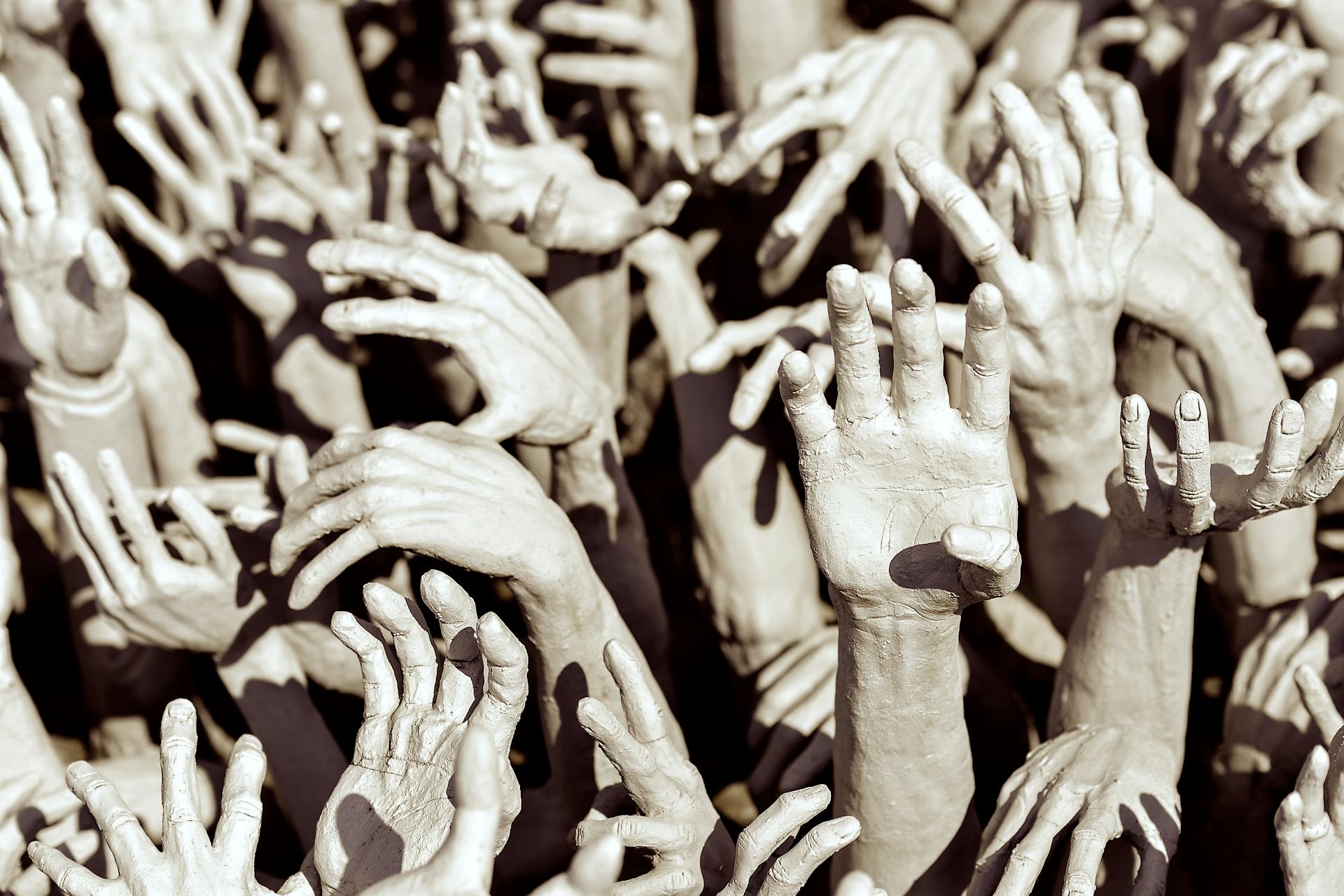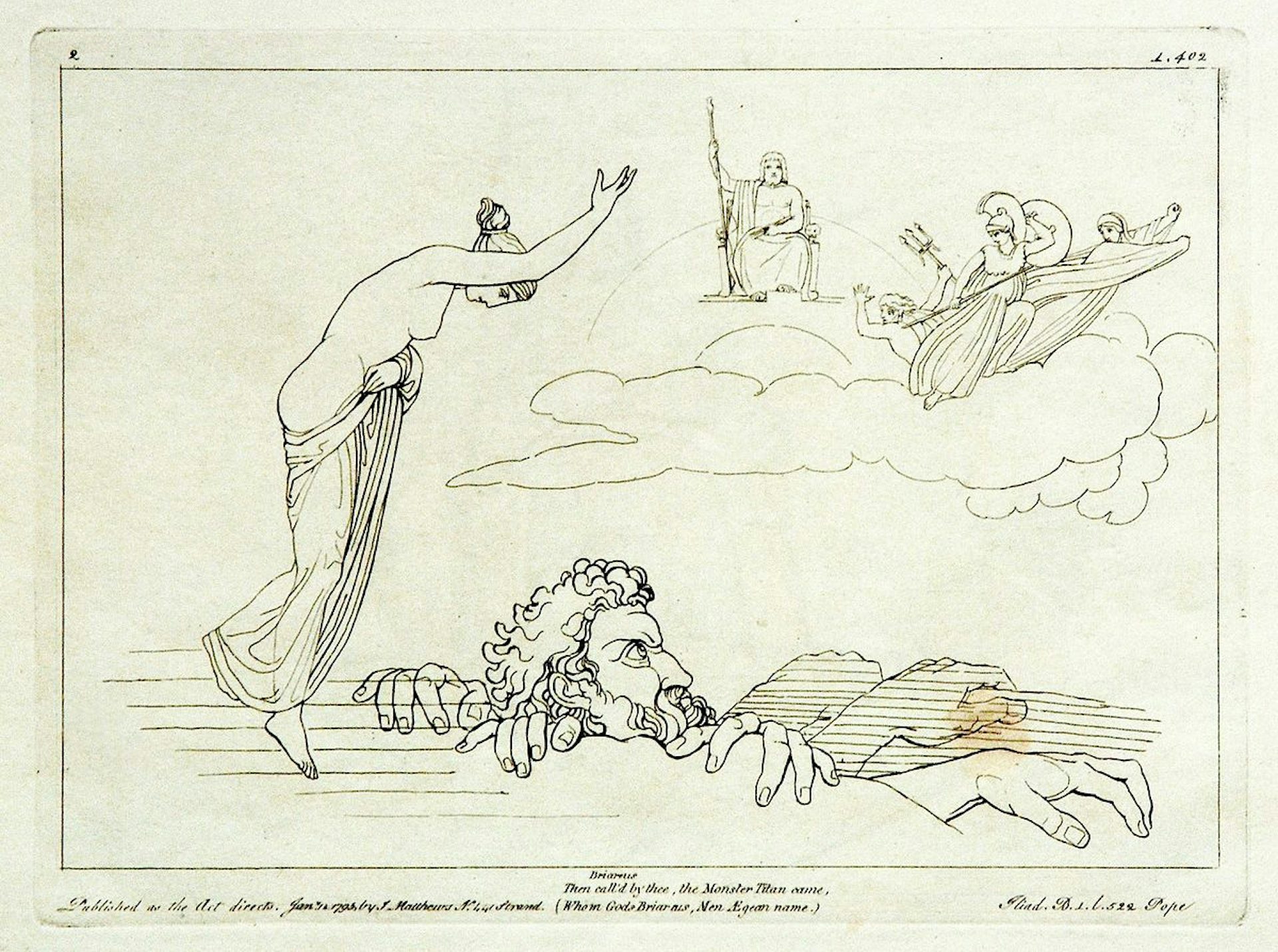Hecatoncheires

The Hecatoncheires, offspring of Gaia and Uranus, were terrifying beings, boasting fifty heads and a hundred hands apiece. Photograph of Pit of Hell in Wat Rong Khun temple, Thailand (n.d.).
kikujungboyAdobe StockOverview
The Hecatoncheires (“Hundred-Handers”) were sons of Gaia and Uranus; in most sources, their names are given as Cottus, Briareus (or Aegaeon), and Gyges (or Gyes). Their appearance was quite terrifying: they boasted fifty heads and one hundred arms each. Along with their brothers the Cyclopes, the Hecatoncheires were imprisoned by the earliest rulers of the cosmos—first Uranus, and then Cronus and the Titans. They were finally released by Zeus, whom they helped overthrow the Titans.
Names and Etymology
The name “Hecatoncheires” (singular “Hecatoncheir”) is derived from the Greek words hekaton (“one hundred”) and cheir (“hand” or “arm”). However, the earliest sources to describe the Hecatoncheires never referred to them collectively by this term, instead using their individual names.
The name of the first of the Hecatoncheires, Cottus, was a common name in Thrace, a region north of Greece known for its harsh winters and warlike tribes. It may be related to the name of the Thracian goddess Cotys.[1]
The second of the Hecatoncheires had two names: Briareus and Aegaeon. Homer’s Iliad explains the two names by saying that Briareus was the name used by the gods and Aegaeon the one used by mortals.[2] To make matters even more confusing, however, the poet Hesiod never calls him Aegaeon but uses both Briareus and Obriareus.
The first of these names, Briareus (or Obriareus), may derive from the Greek briaros, meaning “strong” or “fierce”;[3] according to Martin West, the o- in “Obriareus” is simply an old prepositional affix.[4] Other scholars, however, have argued that the name Briareus/Obriareus is pre-Greek.[5]
The first part of the second name, Aegaeon, is the root aeg- or aig-, which is found in many Greek words associated with the sea, including aigialos (“shore”) and aiges or aigades (“waves”). This could suggest an association with the Aegean Sea, the city of Aegae, or even the god Poseidon (who was sometimes called Aegaeon).[6]
The name of the last of the Hecatoncheires is Gyges or, in some texts, Gyes. Martin West has argued that the name “Gyges” is the more correct form, possibly related to the name of the mythical Attic king Ogyges. The alternative “Gyes” perhaps came about from an association with the Greek work gyion, meaning “limb” (so that “Gyes” would designate “one strong in his limbs”).[7]
Pronunciation
English
Greek
Hecatoncheires Ἑκατόγχειρες Phonetic
IPA
[he-kuh-TON-kheer-eez] /ˌhɛ kəˈtɒn xɪər iːz/
English
Greek
Cottus Κόττος Phonetic
IPA
[KO-tuhs] /ˈkɒ təs/
English
Greek
Briareus Βριάρεως Phonetic
IPA
[breye-ER-ee-uhs] /braɪˈɛərɪəs/
English
Greek
Gyges Γύγης Phonetic
IPA
[JAHY-jeez] /ˈdʒaɪ dʒiːz/
Attributes
The Hecatoncheires, or “Hundred-Handers,” took their name from the one hundred arms they each had. They also possessed fifty heads apiece and were terrifyingly strong. In the Theogony, Hesiod describes them as
great and doughty beyond telling... presumptuous children. From their shoulders sprang a hundred arms, not to be approached, and fifty heads grew from the shoulders upon the strong limbs of each, and irresistible was the stubborn strength that was in their great forms.[8]
For many years, the Hecatoncheires were imprisoned beneath the earth. Eventually, however, they were freed by Zeus.
The Hecatoncheires helped Zeus and the Olympians defeat the Titans and cast them into Tartarus. In some traditions, the Hecatoncheires then became the guards of the imprisoned Titans,[9] though in other versions they settled down in the “Ocean’s foundations.”[10]
Family
The Hecatoncheires were the offspring of Gaia—one of the first beings of the Greek cosmos and the embodiment of the earth—and her consort Uranus, the embodiment of the sky. Their siblings included the three Cyclopes (Brontes, Steropes, and Arges) as well as the original Twelve Titans (Coieus, Crius, Cronus, Hyperion, Iapetus, Mnemosyne, Oceanus, Phoebe, Rhea, Tethys, Theia, and Themis).
Briareus, the most prominent of the Hecatoncheires, married Poseidon’s daughter Cympoleia; according to some traditions, he fathered the nymphs Aetna[11] and Oiolyca by her.[12]
Family Tree
Mythology
Origins
The Hecatoncheires—Cottus, Briareus, and Gyges—were the offspring of the primordial deities Gaia and Uranus. Born with fifty heads and one hundred arms each, they were hated and feared by their father, Uranus. Together with their brothers (the Titans and the one-eyed Cyclopes), the Hecatoncheires were imprisoned by Uranus, who “used to hide them all away in a secret place of Earth so soon as each was born, and would not suffer them to come up into the light.”[13]
This act of cruelty enraged Gaia, and she urged her children to punish their father. Cronus, the youngest Titan, took up her cause and lopped off Uranus’ genitals with a sickle. He then made himself the new ruler of the cosmos.
The Titanomachy
Despite Cronus’ victory, the Hecatoncheires (and the Cyclopes) remained in their prison beneath the earth and were only freed once Cronus’ son Zeus rose up against the Titans.[14] According to Hesiod, the war between Zeus and the Titans—the Titanomachy—had already been raging for ten years when Gaia told Zeus that he would only win with the help of the imprisoned Hecatoncheires and Cyclopes.
Zeus heeded Gaia’s advice and immediately freed the Hecatoncheires and Cyclopes. In gratitude, they agreed to help him in his war against the Titans. The Cyclopes fashioned a mighty lightning bolt and gave it to Zeus to be his weapon. The Hecatoncheires, meanwhile, took up arms and made quick work of the Titans. Hesiod gives a powerful rendition of the scene in his Theogony:
And amongst the foremost Cottus and Briareos and Gyes insatiate for war raised fierce fighting: three hundred rocks, one upon another, they launched from their strong hands and overshadowed the Titans with their missiles, and hurled them beneath the wide-pathed earth, and bound them in bitter chains when they had conquered them by their strength for all their great spirit, as far beneath the earth as heaven is above earth; for so far is it from earth to Tartarus.[15]
The Hecatoncheires thus proved instrumental in helping Zeus win the Titanomachy. Afterwards, Zeus became the ruler of the cosmos. Together with his siblings, he went to live on Mount Olympus, from which the new order of gods derived its name: the Olympians.
What happened to the Hecatoncheires after that is obscure. Hesiod says that they went to live at “Ocean’s foundations.”[16] But Apollodorus writes that the Hecatoncheires stood guard over the Titans imprisoned in Tartarus.[17]
Briareus
The only one of the Hecatoncheires who had an independent mythology is Briareus. According to a story known only from Homer’s Iliad, Briareus once came to Zeus’ rescue when the other Olympians tried to overthrow him. Bound and helpless, Zeus would have been supplanted as ruler of the cosmos, but the sea goddess Thetis enlisted Briareus’ help (who, as Homer obscurely notes, was also called Aegaeon by mortals[18]). With his hundred arms, Briareus easily freed Zeus from his bonds; Zeus then immediately sprang up, grabbed his thunderbolt, and, with Briareus at his side, forced the gods back into line.[19]

Illustration of a myth recounted in Book 1 of Homer's Iliad: Briareus is summoned by Thetis to help Zeus when the other Olympians try to overthrow him. By John Flaxman (1795).
Wikimedia CommonsPublic DomainThere is another obscure myth involving Briareus. It tells of how the sea god Poseidon and the sun god Helios got into a dispute over some land in Corinth. Briareus was brought in as an arbitrator and ruled that the hilltop site of the city, the Acrocorinth, belonged to Helios, while the surrounding land, the Isthmus, belonged to Poseidon.[20]
Other sources claimed that Briareus lived (or was imprisoned) under Mount Etna in Sicily, and that he caused an earthquake every time he shifted his weight or moved his many arms.[21]
There is yet another tradition, preserved only on a single scrap of papyrus, according to which Briareus was the inventor of armor.[22]
Other Traditions
Today, the main source for the mythology of the Hecatoncheires is Hesiod’s Theogony; however, a very different tradition was preserved in another ancient epic, the Titanomachy. Although the text no longer survives, some details are known about its basic outline. For example, it recounted a tradition in which Aegaeon—the Hecatoncheir identified with Briareus—was a son of Gaia and Pontus rather than Gaia and Uranus; this version of Aegaeon/Briareus, moreover, was an ally of the Titans rather than the Olympians during the Titanomachy.[23]
Remnants of this alternative tradition—in which Aegaeon/Briareus (and possibly the other Hecatoncheires as well) fought against the Olympians—can be found in a handful of sources, most of them Roman.[24]
Pop Culture
The Hecatoncheires—especially Briareus—have appeared in a handful of pop culture adaptations. Briareus, for example, features in The Battle of the Labyrinth, one of the books in Rick Riordan’s Percy Jackson and the Olympians series.
The Hecatoncheires have also inspired similar many-armed creatures in various other media, including role-playing games (Dungeons and Dragons, Promethean), video games (Final Fantasy, Ace Combat) and manga and anime (Appleseed, Ghost in the Shell).